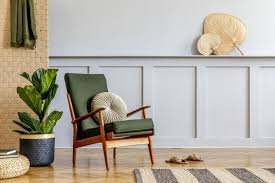Wainscoting is a decorative wall treatment that adds charm, depth, and character to any room. This versatile design element can transform your home, enhancing both its aesthetic appeal and value. In this article, we will delve into the various aspects of wainscoting, including its history, types, installation process, and maintenance tips.
Table of Contents
Understanding Wainscoting
Wainscoting is not just a decorative feature; it’s a blend of art and functionality. Traditionally, it refers to wooden paneling applied to the lower portion of a wall, often topped with a decorative molding. The primary purpose of wainscoting is to protect walls from damage while also providing an elegant look.
Historically, wainscoting was used in grand estates and homes, primarily for insulation and protection against moisture. Today, it remains a popular choice for homeowners looking to add a touch of sophistication to their interiors.
The History of Wainscoting
The origins of wainscoting can be traced back to the 16th century in Europe. Initially, it was made from solid wood and often featured intricate carvings. The term itself derives from the word “wain,” which refers to a wagon. This is because the wood used for wainscoting was often sourced from trees that were transported via wagon.
As architectural styles evolved, so did the designs of wainscoting. From the ornate designs of the Baroque period to the clean lines of modern minimalism, wainscoting has adapted to fit various styles, making it a timeless choice for home decor.
Types of Wainscoting

There are several types of wainscoting, each offering a unique look and feel. Understanding these variations can help you choose the right style for your home.
Board and Batten
Board and batten wainscoting consists of wide boards with narrow strips (battens) placed over the seams. This style is often associated with rustic and farmhouse designs, adding texture and dimension to walls.
Raised Panel
Raised panel wainscoting features panels that are set into the framework, creating a three-dimensional effect. This classic style is commonly used in traditional homes and adds an air of sophistication.
Flat Panel
Flat panel wainscoting is a simpler design that features smooth panels. This style is ideal for modern and contemporary spaces, providing a sleek and understated look.
Beadboard
Beadboard wainscoting consists of narrow vertical planks with a distinctive groove (bead) running along the edges. This style is popular in coastal and cottage-style homes, adding a casual and inviting feel.
Shiplap
Shiplap wainscoting is characterized by overlapping wooden boards, creating a rustic look. This style is commonly found in modern farmhouse designs and can bring warmth to any space.
Choosing the Right Material for Wainscoting
The material you choose for wainscoting can greatly affect the overall look and durability of the installation. Here are some common materials used for wainscoting:
Wood
Wood is the most traditional material for wainscoting. It offers warmth and character, and can be stained or painted to match your decor. However, wood can be susceptible to moisture, so it’s important to choose the right type for humid areas.
MDF
Medium-density fiberboard (MDF) is a popular choice for wainscoting due to its affordability and ease of installation. MDF can be painted easily, allowing for a variety of colors and finishes.
Plywood
Plywood wainscoting is a durable option that can be more cost-effective than solid wood. It’s available in various thicknesses and can be finished in a range of styles.
PVC
PVC wainscoting is a synthetic option that resists moisture and is easy to clean. This makes it ideal for high-humidity areas like bathrooms and kitchens.
The Installation Process
Installing wainscoting can be a rewarding DIY project or a task for professionals. Here’s a step-by-step guide to help you get started:
1. Measure Your Walls
Begin by measuring the height and length of the walls where you plan to install wainscoting. This will help you determine how much material you’ll need.
2. Choose Your Design
Select the type of wainscoting you want to install, and choose the appropriate material. Consider the existing decor and how the new wainscoting will complement it.
3. Prepare the Walls
Ensure that your walls are clean and free of any damage. If necessary, patch any holes or imperfections before proceeding.
4. Cut the Panels
Using a saw, cut the wainscoting panels to the appropriate sizes. Make sure to follow your design’s measurements accurately.
5. Attach the Panels
Start from one end of the wall and work your way across. Use construction adhesive and nails to secure the panels in place. Ensure they are level and aligned.
6. Add Molding
Once the panels are installed, add a top rail and any decorative molding you desire. This will give your wainscoting a polished finish.
7. Paint or Stain
Finally, paint or stain your wainscoting to achieve the desired look. Allow it to dry completely before adding any furniture or decor.
Maintenance Tips for Wainscoting

To keep your wainscoting looking its best, regular maintenance is essential. Here are some tips:
Cleaning
Dust your wainscoting regularly to prevent buildup. Use a soft cloth or duster, and avoid harsh chemicals that could damage the finish.
Repairing Damage
If your wainscoting gets scratched or dented, it’s important to repair it promptly. For minor scratches, a touch-up pen may suffice. For more significant damage, you might need to replace a panel.
Repainting
Over time, your wainscoting may need a fresh coat of paint or stain. Choose a quality product that is suitable for the material of your wainscoting.
Wainscoting in Different Spaces
Wainscoting can enhance the look of various rooms in your home. Here are some ideas on how to use it effectively:
Living Rooms
In living rooms, wainscoting can create an elegant focal point. Pair it with a stylish color palette and comfortable furniture for a cohesive look.
Dining Rooms
Add wainscoting to your dining room to create a formal atmosphere. Consider a raised panel design to add depth and sophistication.
Bedrooms
In bedrooms, wainscoting can add warmth and coziness. Use soft colors and textures to create a serene space.
Bathrooms
Wainscoting can be an excellent choice for bathrooms, especially beadboard or PVC options that resist moisture. This can enhance the overall aesthetic while providing durability.
Cost Considerations
The cost of installing wainscoting can vary greatly depending on the materials used, the complexity of the design, and whether you choose to DIY or hire a professional. Here are some factors to consider:
Material Costs
Wood is typically more expensive than MDF or PVC. However, the durability and aesthetics of wood may justify the higher price for some homeowners.
Labor Costs
If you hire a professional for installation, labor costs can add significantly to your overall budget. If you are handy, DIY installation can save you money.
Additional Features
Custom designs, intricate moldings, or paint finishes can increase costs. Be sure to factor these into your budget when planning your wainscoting project.
The Benefits of Wainscoting
There are numerous benefits to installing wainscoting in your home:
Aesthetic Appeal
Wainscoting adds visual interest and elegance to any space. It can serve as a beautiful backdrop for your decor.
Protection
The primary function of wainscoting is to protect walls from damage, making it ideal for high-traffic areas like hallways and dining rooms.
Increased Home Value
Quality wainscoting can enhance your home’s value, making it a worthwhile investment for homeowners considering resale.
Versatility
Wainscoting can be used in a variety of styles and settings, allowing you to customize your space to reflect your personal taste.
Also read Indigo Color The Rich Legacy and Contemporary Relevance
Conclusion
Wainscoting is a timeless design element that can elevate any room, adding beauty and functionality. Whether you opt for traditional wood, modern MDF, or moisture-resistant PVC, the right wainscoting can transform your home into a sophisticated oasis. With various styles, materials, and installation methods to choose from, wainscoting remains a popular choice for homeowners seeking to enhance their living spaces. By understanding the different aspects of wainscoting, you can make informed decisions that will not only beautify your home but also add lasting value.


